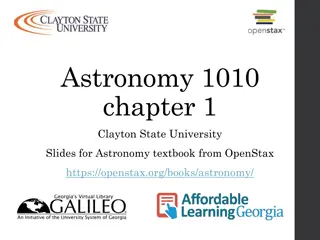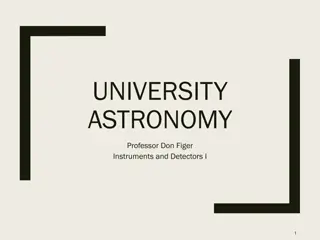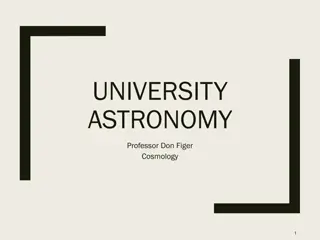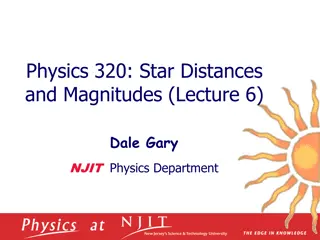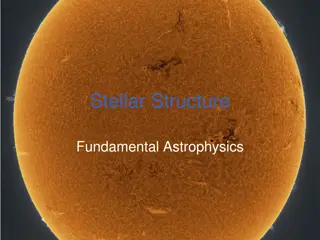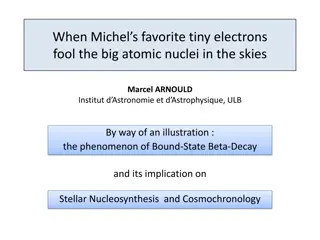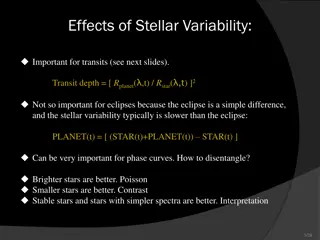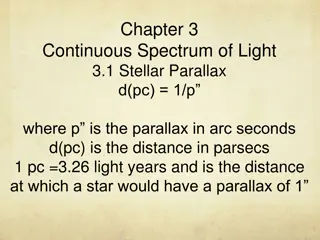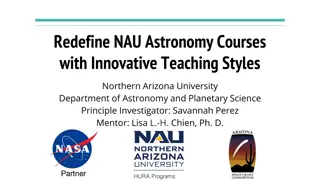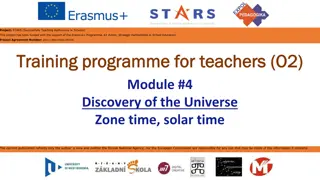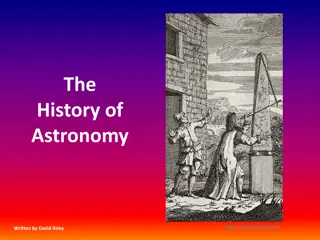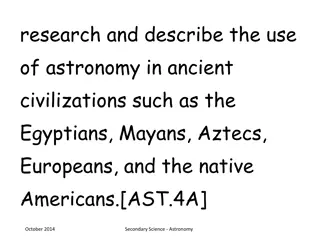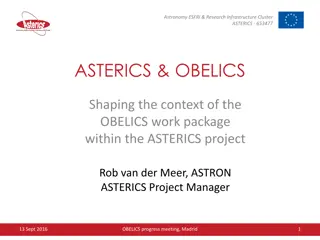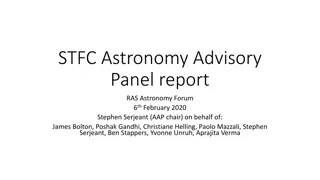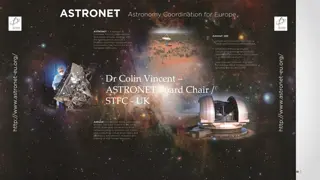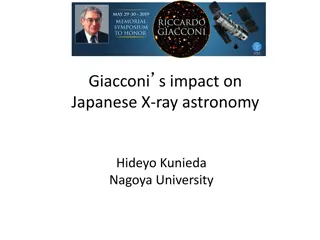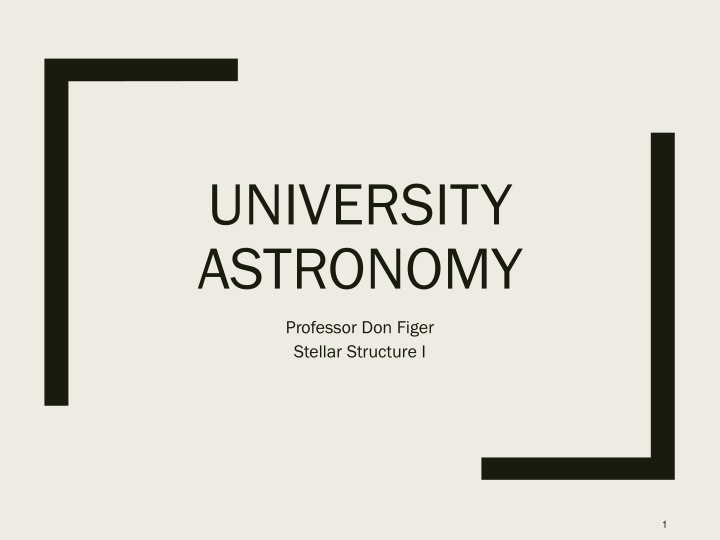
Astronomy Professor Don Figer on Stellar Structure
Delve into the fascinating world of stellar structure with renowned astronomy professor Don Figer. Explore the intricate details of stars, their composition, and evolution through this engaging course. Gain insights into the mysteries of the universe and deepen your understanding of celestial phenomena. Professor Figer's expertise and passion for astronomy will inspire and enlighten students as they uncover the secrets of the cosmos in this captivating academic journey.
Download Presentation

Please find below an Image/Link to download the presentation.
The content on the website is provided AS IS for your information and personal use only. It may not be sold, licensed, or shared on other websites without obtaining consent from the author. If you encounter any issues during the download, it is possible that the publisher has removed the file from their server.
You are allowed to download the files provided on this website for personal or commercial use, subject to the condition that they are used lawfully. All files are the property of their respective owners.
The content on the website is provided AS IS for your information and personal use only. It may not be sold, licensed, or shared on other websites without obtaining consent from the author.
E N D
Presentation Transcript
UNIVERSITY ASTRONOMY Professor Don Figer Stellar Structure I 1
Reminders Midterm #2 Wednesday, 4/1 similar format to that for midterm #1 includes material in reading assignments, lectures, and homework sets covering 2/10 through 3/6 (HW5-8) review session next Monday, on 3/30 2
Aims and outline for this lecture describe understanding of stellar structure present equations that govern stellar structure conservation of mass conservation of energy hydrostatic equilibrium energy transport 3
STELLAR STRUCTURE PHYSICS
What is a Star? held together by self-gravity stabilized from collapse generates energy through fusion 5
Basic Assumptions spherical and spherically symmetric no rotation no external forces uniform initial composition non-relativistic (Newtonian) constant (d/dt~0) no magnetic fields 6
Governing Equations conservation of mass, m(r), mass is neither created nor destroyed conservation of energy, L(r), change in energy flux equals the local rate of energy release hydrostatic equilibrium, (r), forces due to pressure differences balance gravity energy transport, T(r), relates energy flux to the local gradient of temperature 7
Ingredients equation of state, P( ,T) optical depth ( ) energy generation rate, ( ,T) 8
Conservation of Mass Conservation of mass means that mass is neither created, nor destroyed. Stars convert some mass into energy, but that can be ignored for the purposes of deriving stellar structure. Consider the mass in a shell at a particular radius. ?? = 4??2?(?)?? ?? ??= 4??2?(?) 9
Conservation of Energy The conservation of energy dictates that the luminous energy contributed by a mass shell is given by the energy generation rate per unit volume multiplied by the volume of the shell. The luminosity at r is L(r) and is L(r)+dL at r+dr. is energy generated per unit mass per second (W/kg). ?? = 4??2?(?)?? ? ?? ??= 4??2?(?)? 10
Hydrostatic Equilibrium Hydrostatic equilibrium describes the condition in which gas is neither rising nor falling it is static. Consider a cylindrically-shaped collection of gas at radius r, area A, and thickness dr. The outward force is due to pressure on the bottom of the cylinder. The inward force is due to pressure on the top face plus gravity. ? ? ? = ? ? + ?? ? +?? ? ?? ?2 = ? ? + ?? ? +?? ? ?(?)??? ?2 11
Hydrostatic Equilibrium (cont.) Set the inward pressure equal to the output pressure in order to maintain equilibrium. ? ? ? = ? ? + ?? ? +?? ? ?? ?2 ? ? + ?? ?(?) ?? ??? = ?? ? ?(?)??? ?2 ?? ??=? ? + ?? ?(?) ?? ?? ??=? ? + ?? ?(?) = ?? ? ? ? ??? ???= ?? 1 ?2? ?2 ?? ?? ??= ?? ?2? = ??????? also see: https://www.youtube.com/watch?v=b-6RCIuNU10 12
Self-Regulation Hydrostatic equilibrium is a result of self-regulation in a star. Consider the case if the energy generation rate suddenly increased in the center of a star. The temperature and pressure at that location would increase, causing the core to expand. This would reduce the density and temperature in the core. So, the energy generation rate would decrease (due to less fusion). This self-regulation ensures that the star is kept in balance. 13
What Happens If No Fuel? Imagine that the core stopped producing energy (ran out of fuel for fusion). The gas in the core would still be hot just after the turnoff. Heat would escape the core through radiation and convection. Because of the lost heat, the gas would compress under gravity. The core would shrink, becoming hotter. Then, more energy would escape. And so on. This is core collapse and is a result of fuel exhaustion. 14
Energy Transport Stars shine because they are hot. Energy transports from the centers of stars to the outer parts. radiation (photons) convection (bulk motion) conduction (particle collisions) In gas that is fairly transparent, radiation transports most of the energy. This is called radiative transport. In opaque gas, the gas blocks the photons, thus getting hotter. The hot gas pushes upward, transporting energy to higher layers (thus cooling), and then it falls back down. This is called convective transport. Conduction is relatively inefficient in stars. The equations of energy transport are more complicated than the other equations of stellar structure. 15
Equations of Stellar Structure The four equations of stellar structure have four unknowns m(r), L(r), (r), and T(r). They can be solved under the constraints of P( ,T), , and . Boundary conditions: at r=0, M=0, L=0 at r=Rstar, T=Tstar, P=0, =0 16
Energy Generation Energy is generated in a star through nuclear fusion, such as in the proton-proton chain or the CNO cycle. The amount of energy liberated is equivalent to the change in rest mass energies of the input and output particles. For the PP chain, the input particles consist of four protons. The output consists of one helium nucleus. M4 p=6.6905(10-27) kg M1 He=6.6447(10-27) kg M=0.0458(10-27) kg Mc2=4.1(10-12) J 17
Lifetime of Sun The total amount of energy that would be generated by the Sun if it converted all of its hydrogen into helium via the PP chain is equal to the total amount of hydrogen multiplied by the amount of energy generated for each reaction. M4H Hec2*(MSun/(4mp))~1045 J Given the luminosity of the Sun, this would take 100 Gyrs to consume. The real lifetime is one tenth as long because only one tenth of the mass of the Sun gets burned. 18
Lifespans of Stars Luminosity is a strong function of mass, so lower mass stars have a much lower energy generation rate. Because of this, lower mass stars live longest. This means that lower mass stars are more common than higher mass stars. Another factor is that more lower mass stars form than higher mass stars. 19
EQUATION OF STATE AND PRESSURE
Equation of State An equation of state relates pressure to temperature and density. In a star, the total pressure is normally due to gas and radiation. The gas pressure can be represented by the ideal gas law. The radiation pressure is the photon energy flux divided by the speed of light. ??????= ??????/????+??????????+?????????? ??????= ????+?????????? 21
Gas Pressure One common form of the ideal gas law is PV=NkT, where P is pressure, V is volume, N is particle number (ions/atoms and electrons), k is Boltzmann s constant, and T is temperature. We can convert this to P=NkT/V. N/V can be rewritten as /m, where m is the mass per particle. m can be rewritten as mp, where is the mean molecular weight (which is equal to the number of atomic mass units per particle), and mp is the mass of a proton. Using our assumption of spherical symmetry, we find: ? ? =? ? ??(?) ??? 22
Radiation Pressure Photons have momentum (E/c=h/ ) and can exert pressure (I/c), where I is intensity (W/m2). The momentum is conserved when a photon strikes a particle. The momentum along the normal direction of the interaction is transferred. For perfect reflection, the particle attains twice the original momentum of the photon (along the normal direction). 23
Radiation Pressure & Comets We can see the effects of radiation pressure in many astronomical phenomena, such as the appearance of comets. When a comet approaches the Sun, it warms up and its surface begins to evaporate. Some of the gases and dust form tails when they leave the comet. The ion tail (or gas tail) is composed mainly of ionized gases, and it is pushed by the charged particles in the solar wind. The dust tail is composed of heavier and neutral particles that fall behind the comet as it moves. 24
Radiation Pressure in Stars The radiation pressure is Prad=u/3, where u is the energy density of the radiation field. Check the units. Pressure is force (N) per area (m2). Energy density is energy (J) per volume (m3). Energy (J) has units of force (N) times distance (m), so J/m3 is the same as N/m2. It checks out! The energy density of photons generated by a blackbody is 4 T4/c=aT4, where a is the radiation constant, and is equal to 8?5?415?3 3= 4? ?. 4??4 ? ????=? 3=1 =1 3??4 3 26
Total Pressure ??????= ????+ ????=? ? ??(?) +1 3??(?)4 ??? 27
???? ??. ???? Set Pgas to Pradiation to find temperature at which they are equal. Solve for T and take log of both sides. Stars with high T (massive stars) will be dominated by radiation pressure whereas those with low T (low mass stars) will be dominated by gas pressure. ? ? ??(?) ??? =1 3??4(?) ?3? =3? ? ? ???? 28
Temperature at Center of the Sun We can combine the total pressure equation with the equation of hydrostatic equilibrium to calculate the central temperature of the Sun. ??????= ????+ ????~????=? ? ??(?) ??? ??? ? ??? ? ? =?(?) ? ? ??? ? ??= ? ? = 0 =?(? = 0) =?? ? ? = 0 ? ?? ??? ? ??=??? ,?? ??=?? ~15 106? ? ? 29
Homework 9 (due 3/30) 15.1, 15.2 (consider mass of input particles and mass of output particles), 15.3, 15.4, 15.5, 15.6 31

